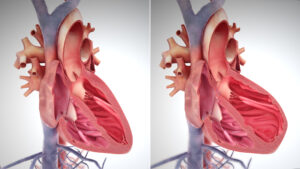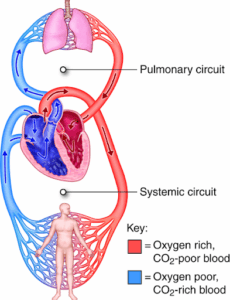Heart failure is when the heart cannot pump blood efficiently to meet the body’s needs. It doesn’t mean the heart has stopped, but rather that it’s struggling to circulate blood. This condition can affect the right, left, or both sides of the heart, and each side tends to produce different symptoms. Understanding right-sided heart failure symptoms vs left is important because it helps identify which part of the heart is affected and guides the treatment approach. Early diagnosis and treatment are crucial – catching the signs of heart failure early can improve outcomes and prevent further heart damage.
In the next sections, we’ll explain right-sided vs left-sided heart failure, the typical symptoms of each, and why distinguishing between them matters.
Understanding Right-Sided Failure
One of the core differences in right vs left heart failure symptoms lies in where the fluid builds up in the body. Right-sided heart failure (right ventricular failure) occurs when the right ventricle cannot pump blood properly to the lungs. As a result, blood backs up in the veins and fluid leaks into the body’s tissues. Often, right-sided heart failure develops as a consequence of left-sided heart failure – when the left side fails, pressure in the lungs rises and overworks the right side of the heart. However, it can also occur due to lung conditions like COPD (chronic obstructive pulmonary disease) or pulmonary hypertension, which put high pressure on the right ventricle. The key feature of right-sided failure is fluid buildup in the body’s lower parts rather than the lungs.
Symptoms of right-sided heart failure to watch for include:
- Swelling in the legs, ankles, or feet: Fluid pooling in the lower extremities causes noticeable swelling.
- Abdominal bloating: Fluid accumulating in the abdomen causes a swollen belly and discomfort. This congestion can also make you feel nauseated and less hungry.
- Bulging neck veins: Increased pressure in the veins may cause the veins in your neck to stick out.
These signs occur because blood is backing up in the venous (body) circulation. If you notice persistent swelling or any combination of these symptoms, it could indicate right-sided heart failure.
Experiencing other heart problem symptoms? It’s important to seek medical advice. Book an appointment with Dr. Iqbal Malik to get a proper evaluation and find a solution for your heart health concerns.
Below you can see an illustration of the right-side heart failure:
Understanding Left-Sided Failure
To continue our look into right vs left heart failure symptoms, let’s turn to the left side of the heart. Left-sided heart failure happens when the left ventricle (the main pumping chamber) cannot pump blood out to the body efficiently. When the left side weakens, blood backs up into the lungs because the heart isn’t moving it forward into the body properly. This causes pulmonary congestion (fluid buildup in the lungs) and means the rest of the body isn’t receiving enough oxygen-rich blood.
Common causes of left-sided heart failure include coronary artery disease (for example, a heart attack that damages the heart muscle) and long-term high blood pressure (which overworks and weakens the left ventricle). Heart valve problems and heart muscle diseases can also lead to left-sided failure.
Symptoms of left-sided heart failure often involve breathing difficulties and fatigue, such as:
- Shortness of breath (breathlessness): Difficulty breathing, especially during activity or when lying flat. You might need extra pillows at night to sleep without becoming breathless.
- Coughing or wheezing: A persistent cough, which may produce frothy or pink-tinged mucus, can occur due to fluid in the lungs.
- Fatigue and weakness: Because the body isn’t getting enough blood flow, you may feel tired and weak, even during routine tasks. Climbing stairs or walking long distances becomes harder than before.
Left-sided heart failure can make everyday activities challenging and should be evaluated by a doctor if suspected as well.
Below you can find the connection between lungs, heart, and supplied oxygen:
Comparing Symptoms: Right vs Left-Sided Heart Failure
Let’s compare right-sided heart failure symptoms vs left side by side. Below are the key symptom differences between right-sided and left-sided heart failure:
| Right-Sided Heart Failure | Left-Sided Heart Failure | |
| Where fluid backs up | In the body’s veins
(systemic circulation) |
In the lungs
(pulmonary circulation) |
| Main symptoms | Swelling in legs, ankles, and feet, abdominal swelling, bulging neck veins. | Breathlessness, especially when lying flat; cough/wheezing; possibly pink frothy sputum in severe cases. |
| Other effects | Weight gain, nausea, loss of appetite (from fluid in belly); frequent urination at night as fluid shifts when lying down. | Extreme fatigue and reduced exercise ability; dizziness or confusion in advanced cases (due to less blood and oxygen to the brain). |
In short, right-sided heart failure mainly causes swelling and congestion in the body, while left-sided heart failure causes breathing problems and tiredness. There can be overlap: for instance, someone with right-sided failure might also feel some breathlessness, and a person with left-sided failure might notice mild swelling in the ankles. Often, if one side of the heart fails, the other side will eventually be under strain as well.
Because symptoms can overlap and one condition can lead to another, doctors use tests like echocardiograms, chest X-rays, and blood tests to determine which side of the heart is primarily affected.
Get in touch with us today to arrange a private heart check.
Treatment Approaches for Left and Right-Sided Heart Failure
Whether you have right-sided or left-sided heart failure, the treatment principles are similar. In managing right-sided heart failure symptoms vs left, the goal is to help the heart pump more effectively and to reduce the fluid buildup causing the symptoms. Treatment typically includes lifestyle modifications, medications, and in some cases advanced therapies.
- Lifestyle changes: Doctors usually advise a low-salt diet to reduce fluid retention and swelling. Regular light exercise (as advised by your doctor) can strengthen the heart over time. If you smoke, quitting smoking is crucial. Also, limiting alcohol can prevent further heart muscle weakening.
- Medications: Common heart failure medications include diuretics (to remove excess fluid and reduce swelling), ACE inhibitors or ARBs (to relax blood vessels and ease the heart’s workload), and beta-blockers (to slow the heart rate and improve pumping efficiency).
- Treating underlying causes: Addressing the root cause of heart failure can significantly improve outcomes. If a heart attack or blocked arteries led to left-sided heart failure, procedures like angioplasty or bypass surgery may restore blood flow to the heart muscle. If a faulty heart valve is contributing, repairing or replacing the valve will help the heart pump more effectively. For right-sided heart failure caused by a lung condition, treating that condition (for example, using inhalers or oxygen therapy) will reduce stress on the right heart.
- Advanced therapies: If heart failure is very severe or not improving with standard care, doctors may consider specialised options. For example, a pacemaker or implantable defibrillator can regulate the heart’s rhythm and improve its coordination.
Final Thoughts
Knowing the difference between right-sided heart failure symptoms vs left can make a big difference in managing your health. To recap, right-sided heart failure typically leads to swelling in the legs, ankles, and abdomen, while left-sided heart failure causes shortness of breath and fatigue. Recognising these distinct patterns is key to early diagnosis and treatment. Remember, the two sides of the heart work together – if one side is struggling, the other side can be affected over time. That’s why getting the correct diagnosis and prompt care is so important.
If you have any questions about your cardiovascular health, contact us for a consultation with Dr Iqbal Malik at London Cardiovascular Clinic.
Article by Dr Malik, a leading UK cardiologist. He works at One Welbeck Heart Health – London’s Largest Private Cardiology Group, and at Hammersmith Hospital, Imperial College Healthcare NHS Trust, London, one of the largest NHS Trusts in the UK.




